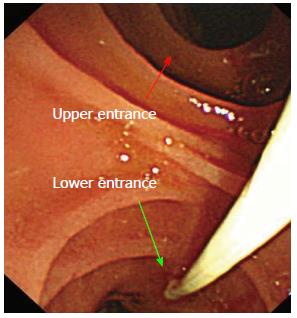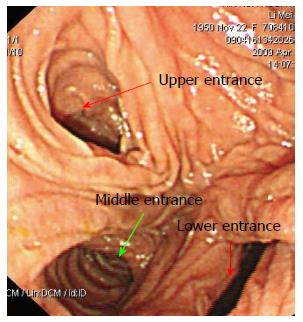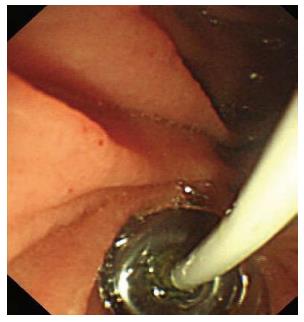Copyright
©2014 Baishideng Publishing Group Inc.
World J Gastroenterol. Aug 21, 2014; 20(31): 10921-10926
Published online Aug 21, 2014. doi: 10.3748/wjg.v20.i31.10921
Published online Aug 21, 2014. doi: 10.3748/wjg.v20.i31.10921
Figure 1 Gastrojejunal anastomosis is detected at the distal end of the stomach, and 2 stomal openings corresponding to an end-to-side anastomosis can be identified endoscopically.
If the efferent loop was constructed at the greater curvature of the stomach in the previous surgery, the “lower entrance” is the entrance to the right efferent loop.
Figure 2 Three stomal openings can be identified endoscopically at the site of the Braun anastomosis, and the “middle entrance” leads to the appropriate loop to reach the papilla of Vater.
The “middle entrance” is unique irrespective of the endoscopic approach used.
Figure 3 We inserted the guidewire of retrieval balloon catheter to the “middle entrance”, and the retrieval balloon catheter is inserted over the guidewire.
Figure 4 Retrieval-balloon-assisted enterography.
A catheter is advanced into the middle limb and contrast injected into the loop to confirm that the limb is the duodenal stump.
Figure 5 Endoscope is then propelled slightly forward, while at the same time the retrieval-balloon catheter is strongly retracted into the working channel to allow the scope to advance.
Then, the endoscope is straightened and advanced to the major papilla.
Figure 6 Optimal enterography routes for endoscopic retrograde cholangiopancreatography in patients with a Billroth II gastroenterostomy and a Braun anastomosis.
- Citation: Wu WG, Zhang WJ, Gu J, Zhao MN, Zhuang M, Tao YJ, Liu YB, Wang XF. Retrieval-balloon-assisted enterography for ERCP after Billroth II gastroenterostomy and Braun anastomosis. World J Gastroenterol 2014; 20(31): 10921-10926
- URL: https://www.wjgnet.com/1007-9327/full/v20/i31/10921.htm
- DOI: https://dx.doi.org/10.3748/wjg.v20.i31.10921














